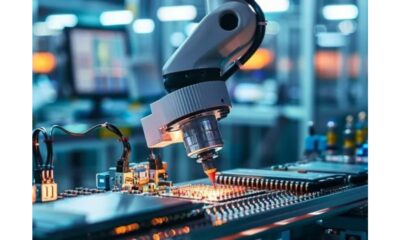Tech
Industry 4.0 Transformation: Utilizing Arduino in Industrial Internet of Things Applications

The Fourth Industrial Revolution, popularly known as Industry 4.0, marks a profound shift in manufacturing and industrial processes driven by cutting-edge technologies like artificial intelligence, robotics, cloud computing, and the Internet of Things (IoT). At its core lies the seamless integration of physical machinery with digital networks, ushering in unprecedented levels of connectivity, efficiency, and flexibility. Amidst this rapidly evolving landscape, Arduino—an affordable, accessible open-source electronics platform—has emerged as a valuable tool for developing innovative Industrial IoT solutions. Arduino boards offer several advantages well-suited for Industry 4.0 applications. Their ease of use, low cost, and compatibility with numerous sensors make them ideal for rapid prototyping and deployment in various industrial settings. From monitoring environmental conditions to controlling complex machinery, Arduino’s versatility showcases immense potential for driving transformation across multiple domains. One area ripe for disruption is predictive maintenance, which aims to anticipate equipment failures before they occur. By analyzing real-time sensor data collected via Arduino devices, manufacturers can identify patterns indicative of impending breakdowns, schedule timely repairs, and prevent catastrophic system failures. Predictive analytics not only reduces downtime and minimizes repair costs but also contributes significantly to overall operational efficiency.
Additionally, Arduino-powered IoT devices enable remote asset tracking and management, empowering plant managers to monitor resources spread across vast geographical areas. By attaching location-aware sensors to assets such as vehicles, containers, or heavy machinery, operators gain insights into usage patterns, movement history, and condition status. Consequently, optimizing logistics, streamlining supply chains, and improving resource allocation become feasible, thereby increasing productivity and reducing waste. Moreover, integrating Arduino-based systems with existing infrastructure allows for smooth migration towards smart factories characterized by adaptive production lines tailored to dynamic market demands. Such agility translates into faster response times, reduced lead times, and enhanced customer satisfaction—key differentiators in today’s highly competitive global economy.
However, leveraging Arduino in Industrial IoT applications necessitates careful consideration of certain challenges. Security vulnerabilities posed by connected devices require stringent protocols to protect against unauthorized access and malicious attacks. Robust encryption methods, secure communication channels, and regular software updates form integral components of a comprehensive defense strategy. Data management is another critical aspect warranting attention during implementation. Ensuring seamless data flow among various devices, gateways, and cloud platforms entails standardization efforts and interoperability testing. Additionally, striking a balance between local processing and centralized analytics determines the effectiveness of real-time decision-making capabilities. Despite these hurdles, Arduino continues to gain traction in Industrial IoT application development owing to its extensive community support, educational resources, and ever-growing library of compatible hardware modules. Its role extends beyond mere prototyping, positioning itself as a viable solution for scalable deployments across industries such as manufacturing, agriculture, healthcare, energy, and transportation.
Embracing Arduino as part of Industry 4.0 transformation strategies offers manifold benefits, including accelerated innovation cycles, increased process efficiencies, and improved product quality. By capitalizing on this versatile platform, businesses can foster resilience, drive competitiveness, and propel themselves to the forefront of tomorrow’s digitally enabled industrial landscape.
In conclusion, Industry 4.0 heralds a new era marked by the convergence of physical and virtual worlds, spawning myriad possibilities for value creation. Among the pantheon of emerging technologies fueling this paradigm shift, Arduino stands out as an indispensable ally in realizing Industrial IoT aspirations. Through judicious utilization of this open-source marvel, enterprises stand poised to reap rich dividends manifested in enhanced operational excellence, elevated customer experiences, and sustained business growth.
Navjot Singh Talwandi
Technical Trainer/Assistant Professor
Chandigarh University
-

 Lifestyle4 weeks ago
Lifestyle4 weeks agoBob Gerace Discusses Coaching Themes: Confession, Reconciliation, Communication, Intimacy, and Fatherhood
-

 Education3 weeks ago
Education3 weeks agoAn Exclusive Interview With Holly Gold: The Heart and Vision Behind The Little Schools
-

 Travel4 weeks ago
Travel4 weeks ago8000 Voices, One Vibe — Ludhiana Sang Every Word with Talwiinder at Bangr Arena
-

 Business3 weeks ago
Business3 weeks agoCorporate Event Catering in Manchester: What Businesses Need to Know (and why Manchester sets the bar)
-
Tech4 weeks ago
Harrington Quality Management System (HQMS): Flagship Platform of Harrington Group International
-

 Business3 weeks ago
Business3 weeks agoCorporate Christmas Gifting Makes a Big Comeback
-

 Apps3 weeks ago
Apps3 weeks agoCanva Launches AI-Powered Design Model and New Creative Features
-

 Travel3 weeks ago
Travel3 weeks agoExploring Europe’s Most Photogenic Cities for Your Next Trip




















